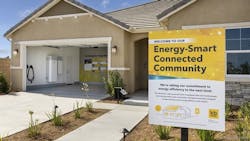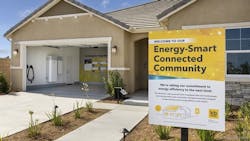Forget pools, clubhouses, parks, and playing fields — the coveted new living community amenity may be the microgrid.
Trendy new residential developments that feature elements of shared power self-sufficiency, control, and management, hallmarks of a microgrid or a mix of site-based distributed energy resources (DER), are popping up from coast to coast at a quickening pace.
At the other end of the spectrum, marginalized communities across the country are beginning to explore the incorporation of DER into “resilience hubs,” resources that help members thrive collectively amidst a multitude of life challenges and include hardened sites that enable them to ride out calamities like extended power outages.
Offering protection from power failures, as well as the prospect of lower energy costs, energy conservation, and a reduced carbon footprint, microgrids and DER arrangements look to be flourishing in the residential/community space. New microgrid research by the power and renewables arm of energy consultancy Wood Mackenzie sees residential communities, broadly defined, becoming the short-term growth engine of new microgrid deployments.
In a presentation at the Microgrid Knowledge 2023 conference in May, senior research analyst Elham Akhavan said evidence points to microgrids expanding in “community/retirement facility” applications through 2025 more rapidly than any other single sector, “displacing the retail sector as the growth engine of microgrids.” See the Figure below. That sector, however, still trails several others in anticipated new deployments, which, combined with projects in the pipeline, hit a record in 2022.
Though each of the recently announced or completed residential projects differ in size, scope, and construction, they largely share core features ranging from local utility involvement, demand response capabilities, and utilization of renewable power sources to grid interconnection, battery storage, and an electrification emphasis.
The most recent to go online incorporates many of those elements and more. Homes in two new subdivisions of Shadow Mountain, a KB Home development near Menifee, Calif., are promoted as being both “green” and highly insulated from power outages (Photo). With a mix of rooftop solar panels, 13kWh battery storage, and smart electrical panels and shared access to a community solar array linked with a 2.3MW battery for storage, homes combine to form a microgrid permitting power sharing and interconnection with the utility electrical grid operated by a project partner, Southern California Edison (SCE). Homes are also fully electric and come with either installed EV charging hook-ups or EV charging-ready wiring.
Though Shadow Mountain is fully operational as the first of its planned 200 homes are occupied, it is a work in progress. With its microgrid development partially funded with a $6.65 million award through the U.S. Department of Energy’s Connected Communities program, the project doubles as a research and development site. Alongside other partners that include the builder, DOE, SunPower, Schneider Electric, and SCE, the University of California-Irvine’s Advanced Power and Energy Program will monitor and study the operation of the microgrid it helped design. It will use its analysis and learnings to refine its operation and guide informed development of future residential microgrids.
Other new residential projects will also contribute to that knowledge base. Two notable ones are a 155-home, all-electric housing development under construction in South Burlington, Vt. that bundles home solar panels and battery storage, EV chargers, and smart electrical panels, and a community microgrid powered by a utility-scale battery storage provided by local utility Green Mountain Power, and an initial 37-home carve-out of a Lennar Homes development in Wimauma, Fla. that utilizes a BlockEnergy distributed renewable energy platform provided by local utility Tampa Electric Company to give homeowners carbon-free, controllable, networkable and, as needed, stored, grid-independent power.
Though not as fully featured as residential projects, microgrids designed for environmentally friendly emergency power backup for larger swaths of communities, as part of resilience hubs, are also taking shape. One underway in Detroit could serve as a model. There, a new 8,000 sq. ft. community center will utilize solar PV, battery storage, and a backup generator to ensure residents can access shelter in the event of a power outage. Microgrids relying heavily on renewable power could emerge as a more economical, greener, and reliable alternative to fossil-fuel-powered backup generators.
A 2018 Urban Sustainability Directors Network white paper on resilience hubs noted that “for many reasons, the common strategy of using standby generators as a resilience strategy is not sufficient resilience hubs.” Instead, a hybrid system that includes multiple types of generation, energy storage (more than a fuel tank), and advanced controls capable of dispatching the optimal mix of generation and storage” could be superior.
About the Author
Tom Zind
Freelance Writer
Zind is a freelance writer based in Lee’s Summit, Mo. He can be reached at [email protected].


